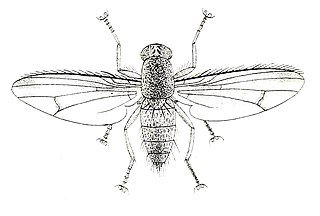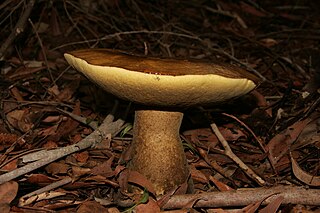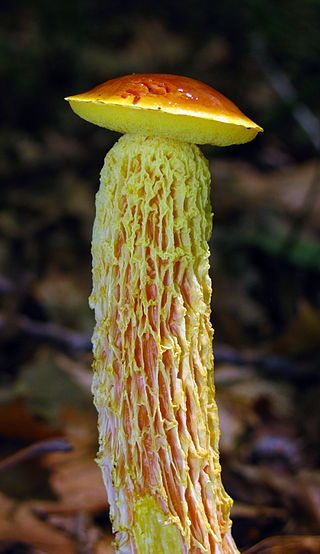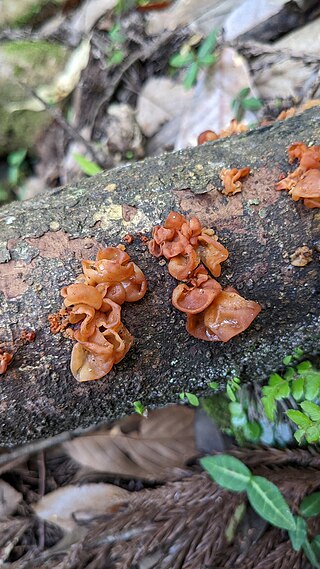
The Russulales are an order of the Agaricomycetes,. According to the Dictionary of the Fungi, the order consists of 12 families, 80 genera, and 1767 species. According to Species Fungorum, the order contains 13 families, 117 genera, and 3,060 species.

Phallaceae is a family of fungi, commonly known as stinkhorns, within the order Phallales. Stinkhorns have a worldwide distribution, but are especially prevalent in tropical regions. They are known for their foul-smelling, sticky spore masses, or gleba, borne on the end of a stalk called the receptaculum. The characteristic fruiting-body structure, a single, unbranched receptaculum with an externally attached gleba on the upper part, distinguishes the Phallaceae from other families in the Phallales. The spore mass typically smells of carrion or dung, and attracts flies, beetles and other insects to help disperse the spores. Although there is great diversity in body structure shape among the various genera, all species in the Phallaceae begin their development as oval or round structures known as "eggs". The appearance of Phallaceae is often sudden, as gleba can erupt from the underground egg and burst open within an hour. According to a 2008 estimate, the family contains 21 genera and 77 species.

The Marasmiaceae are a family of fungi in the order Agaricales. Basidiocarps are most frequently agarics, but occasionally cyphelloid. According to a 2008 estimate, the family contained 54 genera and 1590 species, but molecular research, based on cladistic analysis of DNA sequences, has led to a more restricted family concept, so that the Marasmiaceae included just 13 genera, and some 1205 species. It was reduced further down in 2020, to 10 genera and about 700 species.

The Curtotonidae or quasimodo flies are a small family of small grey to dark brown humpbacked flies (Diptera) with a worldwide distribution, but with very few species in the Nearctic, Australasian/Oceanian, and Palaearctic regions. Most members of the family are found in tropical to subtropical latitudes in Africa and the Neotropics. Many remain undescribed in collections, since little work on the family has been done since the 1930s.

Phlebopus marginatus, commonly known as the salmon gum mushroom in Western Australia, is a member of the Boletales or pored fungi. An imposing sight in forests of south-eastern and south-western Australia, it is possibly Australia's largest terrestrial mushroom, with the weight of one specimen from Victoria recorded at 29 kg (64 lb). Initially described in 1845 as Boletus marginatus, and also previously known by scientific names such as Phaeogyroporus portentosus and Boletus portentosus, it is not as closely related to typical boletes as previously thought.

The Suillaceae are a family of fungi in the order Boletales, containing the boletus-like Suillus, the small truffle-like Truncocolumella, as well as the monotypic genus Psiloboletinus. As of 2008, there are 54 species in the family. Gastrosuillus, once considered a distinct genus, has been shown with molecular analysis to be a recent evolutionary derivative of Suillus. Fuscoboletinus, described by Pomerleau and Smith in 1962, has also been subsumed into Suillus.

The Botryobasidiaceae are a family of fungi in the order Cantharellales. The family contains a group of corticioid fungi that form thin, web-like basidiocarps. Some species form asexual anamorphs producing chlamydospores. All are believed to be wood-rotting or litter-rotting saprotrophs. None is known to be of any economic importance.

The Pilobolaceae are a family of fungi in the Mucorales order. Generally, species in this family have a widespread distribution, although there are some that are restricted to tropical and subtropical regions. This family includes two genera: Pilobolus, and Utharomyces.

Austroboletus is a genus of fungi in the family Boletaceae. The widely distributed genus contains 28 species that form mycorrhizal relationships with plants.

Heimioporus is a genus of fungi in the family Boletaceae. The genus is widely distributed in tropical and subtropical regions, and contains about 15 species.

Cymatoderma is a widely distributed genus of poroid fungi in the family Meruliaceae.

Sarcosoma is a genus of fungi in the family Sarcosomataceae. The name Sarcosoma is derived from ancient Greek and means “Fleshy body” σάρξ σῶμα. The genus is widespread in north temperate areas. The anamorph (asexual) form is the genus Verticicladium.

Galerina sulciceps is a dangerously toxic species of fungus in the family Strophariaceae, of the order Agaricales. It is distributed in tropical Indonesia and India, but has reportedly been found fruiting in European greenhouses on occasion. More toxic than the deathcap, G. sulciceps has been shown to contain the toxins alpha- (α-), beta- (β-) and gamma- (γ-) amanitin; a series of poisonings in Indonesia in the 1930s resulted in 14 deaths from the consumption of this species. It has a typical "little brown mushroom" appearance, with few obvious external characteristics to help distinguish it from many other similar nondescript brown species. The fruit bodies of the fungus are tawny to ochre, deepening to reddish-brown at the base of the stem. The gills are well-separated, and there is no ring present on the stem.

Setchelliogaster is a genus of fungi in the order Agaricales. It is incertae sedis with respect to familial placement within the order, although Kirk and colleagues consider it likely aligned with either the Bolbitiaceae or the Cortinariaceae. Species Fungorum class it as in the Bolbitiaceae family. The genus is widespread in warm, dry areas, originally containing five species, later degraded to 3 species. It was circumscribed by Czech mycologist Zdeněk Pouzar in 1958.
Labyrinthomyces is a genus of truffles in the Tuberaceae family. The genus, circumscribed by Karel Bernard Boedijn in 1939, contains seven species found in Australia.
Karel Bernard Boedijn was a Dutch botanist and mycologist. Born in Amsterdam, he graduated with a PhD from the University of Amsterdam in 1925; his thesis was titled "Der Zusammenhang zwischen den Chromosomen und Mutationen bei Oenothera lamarckiana".

Nils Gustaf Lagerheim (1860–1926) was a Swedish botanist, mycologist, phycologist, and pteridologist.
Lichtheimiaceae is a family of fungi in the order Mucorales. The family was circumscribed in 2013 after a molecular phylogenetic analysis helped delineate a new family structure for the Mucorales.
Leucocoprinus zeylanicus is a species of mushroom producing fungus in the family Agaricaceae.

Sirobasidium magnum is a species of fungus in the order Tremellales. Basidiocarps are gelatinous, lobed to foliose (leaf-like) and appear to be parasitic on ascomycetous fungi on wood. No other Sirobasidium species has such large fruit bodies. The species was originally described from Indonesia, but has been reported from elsewhere in Asia and also in Australia and North America.

















